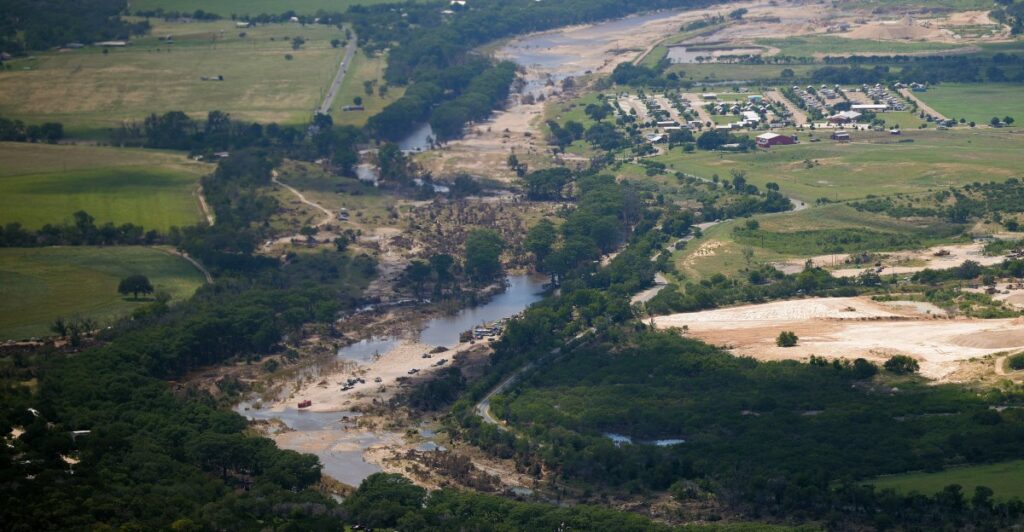
Flash floods have wrought more havoc in the US this week, from the Northeast to the Midwest, just weeks after swollen rivers took more than 130 lives across central Texas earlier this month. Frustrations have grown in the aftermath of that catastrophe over why more wasn’t done to warn people in advance.
Local officials face mounting questions over whether they sent too many or sent too few mobile phone alerts to people. Some Texans have accused the state of sending out too many alerts for injured police officers in the months leading up to the floods, which may have led to residents opting out of receiving warnings. And hard-hit Kerr County, where more than 100 people died, lacked sirens along riverbanks to warn people of rising waters.
These are all important questions to answer that can help keep history from repeating itself in another disaster. Failing to translate flood forecasts into timely messages that tell people what they need to do to stay safe can have tragic consequences. In Texas and elsewhere, the solution is more wide-ranging than fixing any single channel of communication. The Verge spoke with experts about what it would take to design an ideal disaster warning system.
The solution is more wide-ranging than fixing any single channel of communication
When you have a matter of hours or maybe even minutes to send a lifesaving message, you need to use every tool at your disposal. That communication needs to start long before the storm rolls in, and involves everyone from forecasters to disaster managers and local officials. Even community members will need to reach out to each other when no one else may be able to get to them.
By definition, flash floods are difficult to forecast with specificity or much lead time. But forecasts are only one part of the process. There are more hurdles when it comes to getting those forecasts out to people, an issue experts describe as getting past “the last mile.” Doing so starts with a shift in thinking from “‘what will the weather be’ to ‘what will the weather do,’” explains Olufemi Osidele, CEO of Hydrologic Research Center (HRC), which oversees a global flash flood guidance program. The technical term is “impact-based forecasting,” and the goal is to relay messages that help people understand what actions to take to keep themselves safe.
In the hours leading up to devastating floods in central Texas, the National Weather Service sent out escalating alerts about the growing risk of flash floods. But not everyone received alerts on their phones with safety instructions from Kerr County officials during crucial hours, according to records obtained by NBC News. While meteorologists can say there’s a life-threatening storm approaching, it typically falls to local authorities to determine what guidance to give to specific communities on how and when to evacuate or take shelter.
“Emergency responders need to know what are the appropriate actions to take or what’s needed in the case of a flash flood before an event happens so that they can react quickly, because the time to respond to that event is likely very short,” says Theresa Modrick Hansen, chief operating officer at HRC. “Time is really the critical issue for disaster managers.”
Without prior planning, local alerting authorities might be stuck staring at a blank screen when deciding what warning to send to people in the heat of the moment. Many alerting platforms don’t include instructions on how to write that message, according to Jeannette Sutton, an associate professor in the College of Emergency Preparedness, Homeland Security and Cybersecurity at the University at Albany, SUNY. Sutton is also the founder of The Warn Room and consults with local organizations on how to improve their warning systems.
“When you sit down at the keyboard, you have a blank box that you have to fill in with the information that’s going to be useful to the public,” Sutton says. “And when you are in a highly volatile, emotional, chaotic situation, and you all of a sudden have to create [a] message very quickly that is really clear and complete and directed to the right people at the right time, it’s really hard to think of all of that in the moment.”
There aren’t national standards for how a flood alert system should work in the US, so practices vary from place to place. Sutton recommends an end-to-end warning system that connects each step of the process and the people along the way. It includes forecasters and hydrologists who collect data and run it through predictive models to understand the potential impact on communities — identifying which specific populations or infrastructure are most vulnerable. They need to get that information quickly to disaster managers who can then reach people most at risk with safety instructions using channels of communication they’ve thought through in advance.
Ideally, those alerts are tailored to specific locations and give people clear instructions — telling them who should evacuate, when, and where, for instance. A strong message should include five things, according to Sutton: who the message is from, what the hazard is doing, the location and timing of the threat, and what actions to take to protect yourself.
“If you are receiving a warning that’s statewide or county wide, it can be difficult for some people to understand if they should act or evacuate,” says Juliette Murphy, CEO and co-founder of the flood forecasting company FloodMapp. “Or if a warning states that a river will reach 30 feet, that might not mean much to some people if they don’t have a hydrology understanding.”
Murphy’s company is now using its mapping tools to help state and federal agencies find dozens of people still missing since the July 4th floods. FloodMapp hadn’t worked with counties affected by the floods prior to this disaster, but Murphy says she’d like to work with local agencies in the future that want to improve their warning systems.
Kerr County is under scrutiny for lacking flood sirens, even though county commissioners had been talking about the need to upgrade its flood systems — including adding sirens — since at least 2016. The county sits in an area known as “flash flood alley” because of the way the hilly topography of the area heightens flood risk during storms. Sirens in neighboring communities have been credited with saving lives.
“If I were to envision a really good, robust warning system in flash flood alley, I would say that there would be sirens in these very rural, remote areas,” Sutton says.
Sirens can be critical for reaching people outdoors who may not have cell service and are hard to reach. Even so, it’s no silver bullet. The sound doesn’t necessarily reach people indoors who are further from the riverbanks but still in harm’s way. And it doesn’t provide clear instructions on what actions people need to take.
Along with sirens, Sutton says she’d recommend making sure communities are prepared with “call trees” in advance. That means people are physically picking up the phone; each person is responsible for calling three more people, and so on. “It’s the human touch,” Sutton says. In worst-case scenarios, that might include going out to pound on neighbors’ doors. And that human touch can be especially important for reaching someone who might be skeptical of a government agency sending an alert but might trust a friend or fellow church member, for example, or for those who speak a different language than what officials use.
Wireless emergency alerts are also critical; Sutton considers them the most powerful alerting system across the US because it does not require people to opt in to get a message. But there are also warning systems that people can opt in to for alerts, including CodeRed weather warnings. Kerr County used CodeRed to send out warnings to people subscribed to that system, and audio recordings from disaster responders on July 4th have raised more questions about whether those messages were too delayed to keep people out of danger.
In an email to The Verge, a Kerr County spokesperson said the county is committed to “transparency” and a “full review” of the disaster response. State lawmakers start a special session next week and are expected to consider legislation to bolster flood warning systems and emergency communications. One Senate bill would let municipalities gather residents’ contact information to enroll them in text alerts that they could opt out of if they don’t want to receive them.
Disaster fatigue and Swiss cheese
People opting out of notifications has also been a concern — particularly after a deluge of “Blue alerts” sent after a law enforcement officer has been injured or killed. Frustrations have flared up on social media this month over a statewide Blue alert issued for someone suspected of being involved in the “serious injury” of a police officer at an Immigration and Customs Enforcement (ICE) detention facility in Alvarado, Texas. “Texas can’t adequately warn people about deadly floods, but it can immediately let me know that a cop got hurt 250 miles away from me,” one post with more than 20,000 likes on Bluesky says. The FCC has received thousands complaints about the Blue alert system in Texas, CBS News reported in October of last year.
“Alert fatigue” is a concern if it pushes people to ignore warnings or opt out of receiving them altogether. That can be an issue during extreme weather if authorities include Blue alerts and extreme weather warnings in the same “imminent threat” category of wireless emergency alerts. Again, this can vary from locality to locality. “It’s really frustrating when they choose to send a Blue alert through an imminent threat channel,” Sutton says. To stop getting those pings about police officers, someone might opt out of the imminent threat category of wireless emergency alerts — but that means they would also stop getting other alerts in the same channel for weather emergencies.
“This is exactly what we don’t want to have happen, because when you turn it off you’re not going to get the message for that flash flood. So it’s really dangerous,” Sutton says.
“This is exactly what we don’t want to have happen”
Even so, we still don’t have data on who might have missed a lifesaving alert because of frustration with Blue alerts. Nor do we know the extent to which people are just ignoring notifications, or why. The number of public safety alerts sent in Texas has doubled since 2018 for a wide range of warnings, including Blue alerts, Silver alerts for missing elderly adults, Amber alerts for missing children, and more, the Houston Chronicle reports.
And when it comes to warning people about flash floods in particular, experts still stress the need to get warnings to people via every means possible. If someone misses a wireless emergency alert, there should be another way to reach them. There are likely going to be gaps when it comes to any single strategy for alerting people, as well as other complications that can impede the message getting out. (On July 4th, floodwaters rose in the dead of night — making it even harder to notify people as they slept.)
That’s why a “Swiss cheese” approach to warning people can be most effective in overcoming that last mile, Chris Vagasky, a meteorologist and manager of the Wisconsin Environmental Mesonet at the University of Wisconsin-Madison, explains. (And it’s similar to an ideology used to prevent the spread of disease.)
“You know you got slices of Swiss cheese and they’ve got holes in them. Nothing is ever perfect. But if you layer enough pieces of cheese, it reduces the risk because something might go through one hole, but then it gets blocked,” Vagasky says. “We always want people to have multiple ways of receiving warnings.”
 Latest World Breaking News Online News Portal
Latest World Breaking News Online News Portal






